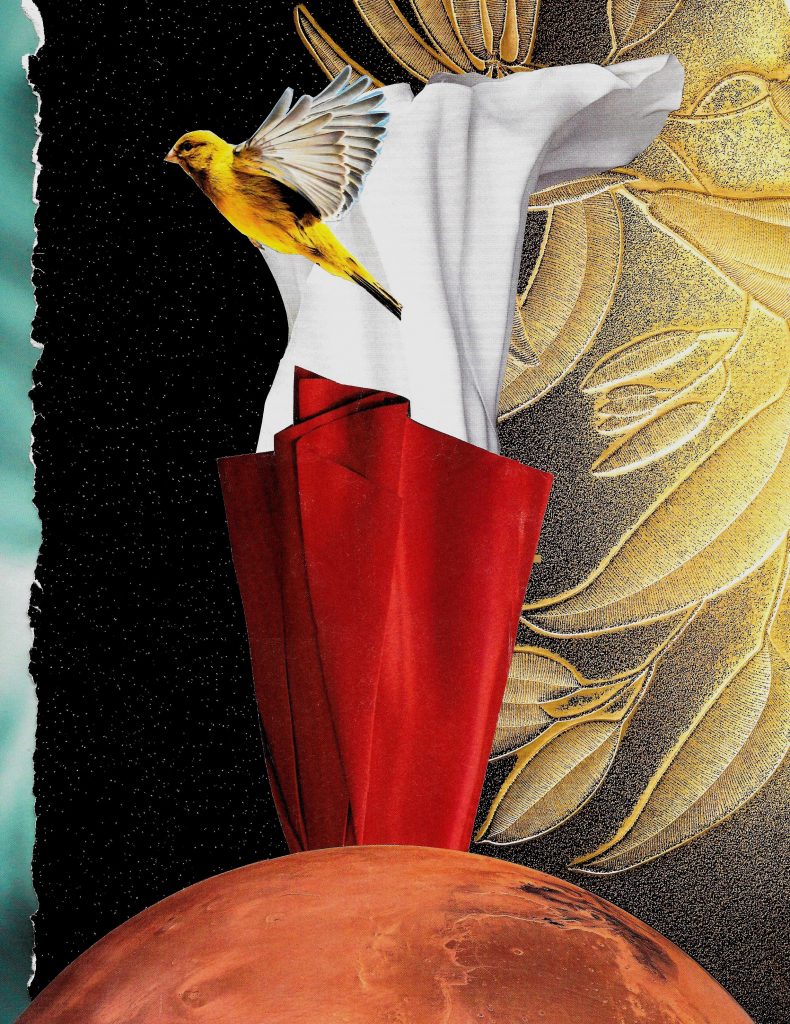Minting NFTs of your artworks can be a costly scam, if you are not aware
By Ken Magri
“Never drive a hard bargain with an artist.” -Ludwig van Beethoven
Scams are never a good thing, but they are even worse when they go after visual artists who seek nothing more than to bring some beauty into our world. This year, there has been a flurry of different crypto currency scams involving artists and Non-fungible tokens (NFTs).
Last February, a fake Banksy artwork sold as an NFT for one million dollars worth of Ethereum on the marketplace website Rarible. The scammers even claimed that 5% of sales would be donated to charities. In April, a Brooklyn artist saw several of his digital artworks illegally listed on Rarible and had them taken down before the plagiarist could pocket any sales.
A popular Japanese anime artist named Qinni died last year, but had her identity posthumously stolen by scammers who then sold NFTs of her art on the website Twinci. Another anime artist, Loish, sent out warnings to her fans that any NFTs of her artworks were fakes.
For those still confused by the acronym, an art NFT is a digitally encoded asset that contains electronic data about a real art image. The NFTs are traded online using any number of crypto currencies, but most often Ethereum, which is the second most expensive on the market, after Bitcoin.
The art NFT is not the actual image, but a link to that image. That is why many experts think NFTs are a worthless fraud, comparable to the great 17th Century Dutch tulip-mania, when people sold their homes to buy hybrid tulip bulbs that eventually became worthless.
“Most NFTs are scams. If you’re buying an NFT, there is a good chance you’re being ripped off,” said Alex Stamos, a Stanford University adjunct professor speaking at Toronto’s Collision Tech Conference last May.
More recently, scammers began reaching out to artists and conning them into paying Ethereum to have NFTs made from their artworks, before running off with the money. None of this surprised me when learning about it.
The surprising part was that I became one of these new victims.
In a scheme that took almost a month to unfold, crypto currency scammers conned me out of 0.45 Ethereum, which amounted to about $950 at the time. I won’t be getting any of that money back, but I hope to take some sting out of the loss by helping others keep from being cheated. Here’s my story.
The initial hook

Last June, I received an email from a person calling himself Tyler Donald, who said he was an executive with Digital Currency Group, a venture capital firm based in Connecticut that sells NFTs of artworks. “Donald” mentioned that he saw my hand-made collages on the social networking site Ello, which has a “Hire Me” feature to foster new business for artists. Donald explained that DCG wanted to mint and market my art as NFTs for a 20% commission.
“We want to make our collection a unique one that is why we are looking to contract digital artist to create digital artworks that would be adopted and distributed to the investment portfolio of our accredited and institutional investors,” read Donald’s email.
I noticed the run-on sentence and the grammar error, and should have taken pause right there. This was a first mistake, according to Joseph Steinberg, who owns the New York cyber-security business JosephSteinberg.com. “Scammers often intentionally make spelling mistakes and grammatical errors in their communications with would-be victims,” Steinberg told SN&R. “Doing so helps scammers focus their attention on people who are most likely to succumb to scams rather than to realize that they are being scammed before handing over money,” he said.
But Steinberg said there is another reason for the mistakes. “Minor text errors make scam emails look more human-written and improve the odds that the message will get through spam filters,” he said.
Unleashing the scam

Digital Currency Group asked me to pay them 0.5 Ethereum (about $1,100 at the time), in order to mint1000 NFTs of a single image from works I submitted. Donald explained that the cost to mint all the NFTs would also match the sale price for one NFT.
“The staking of price is required on your end in order to fully incorporate your personal address as the authors wallet address,” wrote Donald. “It registers your Ethereum address as the creators address and also fixes the price of the per copy of the NFT artwork.”
At that price, a complete sell-out of the NFTs could earn hundreds of thousands of dollars.
Doing my research
It’s not like I didn’t check into all of this.
I conducted a search on DCG and it seemed to check out as a real block-chain investment firm, apparently begun in 2015 by someone named Berry Sidler. It owns Grayscale Investments LLC, considered a leader in digital investing, and has crypto currency holdings in the billions of dollars. Former Treasury Secretary Larry Summers is on DCG’s advisory board.
I then talked to a friend, Paul Marquis, who worked several years in the digital currency field, and asked him if DCG was legitimate. “DCG is a legit company, but I’m not sure why they would charge an upfront fee,” said Marquis.
He explained that I might want to shop around first. “If you think you want to go down this road, it’s probably advisable to explore a few other offers and leverage them against each other.”
I should have taken Marquis’ advice, but didn’t. Instead, I researched the minting and selling of NFT artworks, and learned that there is a lot of money to be made through websites like OpenSea, SuperRare, and MakersPlace, where investors buy and resell art NFTs on speculation. I was also aware, like many others, of the March 11th auction of an art NFT by the artist Beeple, which gaveled in at $69 million.
Then I conducted a search on Tyler Donald, and found his profile photo on Instagram. He looked like a person that worked in investing, and his posts showed photos of digital currency. But I didn’t notice another warning, that Donald only had three posts, photos of crypto currency tokens with no captions, comments or likes.
Donald acknowledged my doubts and suggested I get in touch with a person who went by Matt Beck, Director of Investments at DCG. I wrote to Beck that I didn’t want to risk 0.5 ETH on 1000 NFTs, and that I didn’t think the image would sell for 0.5 ETH (around $950 at the time). He suggested that they instead create only 500 NFTs for a minting price of 0.25 ETH. In other words, pay half as much to mint and sell half as many, which sounded more reasonable.
But being asked to pay in Ethereum was another red flag. The Federal Trade Commission warns about paying with crypto currencies on its website.
“One sure sign of a scam is anyone who says you have to pay by crypto currency,” reads the federal warning. “In fact, anyone who tells you to pay by wire transfer, gift card, or crypto currency is a scammer.”
Despite red flags, I take the bait

It’s almost like I didn’t want to acknowledge these warnings.
Sometimes the vanity of artists can blind them when it comes to admiration, and I was a willing dupe. The scammers sealed the deal when they chose “Fly by Night,” a collage I had made years ago that held special significance. This was giving me such a great feeling that I began to dream about creating new collages for minting into new NFTs.
In subsequent emails, Donald and I talked about more personal things. I asked how he found my work on Ello. He said that recruiting artists was part of his quest for a promotion. I was still slightly suspicious, but he certainly wasn’t a bot. I weighed a possible loss of money (not from a scam, but if no NFTs sales) against the possibility of big gains.
But my break-even point would be reached by selling a single NFT, so I decided to go ahead with the deal. I opened a Coinbase account, bought $1,250 worth of Ethereum to start my new enterprise, and went ahead with the deal.
I also searched Matt Beck online and, yes, there was his photo on the DCG website. Everything was still generally checking out. Beck finally sent me a wallet address and I transferred the first 0.25 ETH (about $550) to what looked like a string of letters and numerals, 34 characters long.
It was done now, and all I needed was to wait for the sales to come. But the scammers were not done with me.
Throwing good money after bad
A few days later I received an email from Matt Beck, telling me that a new business had to be formed for me, so that I could legally sell the newly minted NFTs online.
“Your regulation ‘D’ rights transfer is at the final stage and a final security deposit of 0.2 ETH has been required before this document is can be released to you and also you have to complete our KYC procedure,” Beck wrote.
They wanted more money and information to create a dashboard where I could monitor my sales.
Regulation D rights allow capital to be raised “through the sale of equity or debt securities without the need to register those securities with the SEC,” according to Investapedia.com.
A KYC procedure (meaning Know Your Client) is an effort to verify the identity, suitability and risks of a particular business relationship.
This all confused me a bit, but still seemed logical. Beck emailed a list of informational items to complete, including a request for my most recent business tax returns. I was dubious about that request, but continued to believe the scammers, and sent along the information, only without any tax returns. I also sent another 0.2 ETH (about $400).
During all of this period, Donald was still texting and emailing me. “How are things going?” he asked. “Please keep me informed.”
Again and again, Donald reassured me. “I’m sure looking forward to seeing this successful, so far the two other artists successfully launched their NFTs, I have no doubt about yours, and I can assure you our platform is legit. There’s nothing to worry about,” he wrote.
Did you notice the run-on sentence in his email? Looking back, it is crazy how many clues I missed or ignored. Young crypto business executives were interested in my art. There was a chance for big, big returns with little risk. That’s all I wanted to see.
Uh-oh

But the final warning was a clear one. By now, the scammers must have thought I would be good for a lot more money. After being told that my new business papers were being sent by courier, I received a late-night email from the courier service itself, Trust Way Couriers. This time, bad punctuation and grammar was so glaring, even I was alerted:
“We are writing you regarding the package sent to you by MR The Digital Currency Group and we want to let you know that the package have arrive safe and charges of $1,000 have been imposed on you and this charges need to be paid as soon as possible and we hope to read from you soon we have the following easy payment mode Such like payment through 1. Bitcoin Machine 2.ETC”
Finally my face turned white. Every suspicion I had just got confirmed. I sent Beck and Donald both “WTF?” emails, and demanded to speak to a real human. Beck responded with, “I understand that you can be very furious right now, but I will ask Jonathan Han (DCG Fundamental Analyst) to reach you immediately.”
A call came in a few minutes later, but the person on the other end had a strange voice and was mumbling so much, I had to ask “What is your name, again?” He said “Jonathan Han.” He told me there was nothing that could be done about the courier charge, and to “work with them.”
But I knew my 0.45 ETH was gone, and not coming back. I sure wasn’t going to give them another $1,000 worth of Bitcoin.
Trying to fight back
Crypto currency theft is almost impossible to recover, and cannot be reported as a loss on one’s income taxes. It can be reported as fraud on several government and consumer advocate websites, which I did. But those sites do not conduct investigations. Their purpose is to help stop future scams by sharing the information.
Although financial recourse was impossible, I wanted to find out as much about my scammers as possible. Reverse searches on the two email addresses from Tyler Donald and Matt Beck revealed no information whatsoever. Huh?
But a BeenVerified search of the names provided real email addresses that were different from those of the scammers. Were they imposters? I emailed who could be real Matt Beck at DCG, saying that someone was assuming his identity for a scam. No reply.
I emailed who could be the real Jonathan Han, and the company’s supposed CEO, Barry Sidler, and explained the scam to them, asking for an acknowledgement that DCG executives were not the scammers. No replies.
Could the scammers actually be the DCG executives they claimed to be? It didn’t make sense. But neither does it make sense that a reputable company would not want to know if scammers were impersonating them. Apparently Digital Currency Group doesn’t care.
“People in the crypto currency world can be paranoid about talking to the public and the press,” said Paul Marquis. “They don’t know whether someone might be trying to scam them,” he said.
Then, I searched Trust Way Couriers and found two completely different websites with different contact information. Would scammers set up a completely fake website just to fool someone? “Yes,” said Joseph Steinberg. “Scammers do that kind of thing. Their payoff is worth their investment of time and money.”
I conducted searches on the wallet address the scammers gave me for transferring money. But the search showed transaction histories only. It is not possible to find out who owns that wallet address. It did show, however, that the balance is never more than $1000, and the wallet gets emptied out shortly after a few transactions have been made. So far, they have processed a little over $7,000 through their scam wallet. The current balance was $1.79.
At that point, my investigation hit a dead end.
It had been a month since this scam began, and as I wrote the article, the person claiming to be Tyler Donald was still sending me emails, trying to get that last $1,000 in Bitcoin. I pretended to lose the wallet address and claimed a new one didn’t work. That took a week.
I lied and said Coinbase held up the transaction because it suspected a scam. Donald sent yet another wallet address. After that, I claimed to be up in the Sierras camping on mushrooms, and he finally sent an angry email message. It is a common last-chance tactic.
So, I let him know I was just trying to waste his time and the emails stopped.
What possible good can come from being scammed?
If you are still reading, you are better informed about crypto currency scams, and won’t make these mistakes.
I learned that the only way to beat a scammer is to not take the bait, and that bad punctuation and bad grammar are the first big warning signs.
If you are being asked to pay in crypto currency, try offering cash instead, to see how the other party reacts. “Cash can be traced,” said Paul Marquis. “If you offer to wire cash, a legitimate business will always say yes.”
In short, do a lot of detective work before getting involved in crypto currencies and NFTs, because all the work you do after being scammed will not be as rewarding.


Thank you for sharing your story, many people may think they are too smart to get scammed but it happens all the time. NFTs may have been made with the intent to make art more marketable but they just spawn more scams since, as was pointed out, there’s no way to verify the person who made the NFT in any way owns the actual work it points to.
Saddens me also that so many people are investing in cryptocurrency for the same reason. It’s primary purpose is just to be passed back and forth to create an illusion of generating wealth and to help scammers evade tracking. Even the main inventor of Bitcoin itself has disappeared from the public eye and the main creator of Dogecoin has publicly said he regrets what he did.
Thanks for this artickle Ken I got approached by the same company and person and I googled them and found your article!
They approached me through Ello too so I blocked them and flagged them. Not sure that that will do any good but at least they will have to have a look at the account.
Best regards,
A
Thanks.l also was approached by a person from same company.
Thanks for this. I was reached out to by a different name from the same company. Good information to know
I also was approached by someone through Ello. Same spiel…same grammatical and spelling errors which were the first red flags. The second was I could not find (google) the person at all, they are a ghost. I did google the additional and different name that came through the second email when I asked for more information, and when I did there was a facebook account with the man’s name, but the account belonged to a woman. I think Ello should be aware of these scammers, is there nothing we can do?
Thanks for your article!
I was reached out by a different name from that company too. Luckily I found your post.
Victims of Funds/crypto and other digital assets such as NFTs kept increasing on daily basis. This is so disheartening and discouraging potential investors to partake in the ever-blooming world of digital currencies that have a lot of profits. However, you are rest assured your funds can be recovered if you’ve been swindled by this online evil scheme. Have you heard about Matt Dunham? He’s a prolific and genuine fund recovery expert who uses newer technologies to recover stolen funds vai; MattDunhamTrading {at} Consultant. com
I was scammed by DCG and trying to reach out to someone for help.